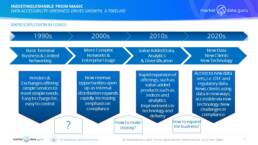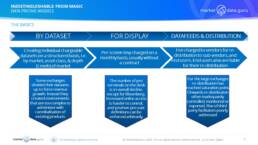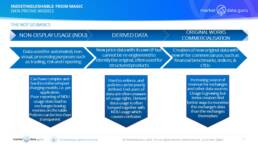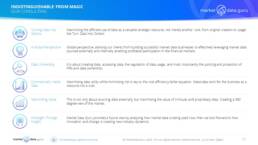
A WITCH’S BREW
THE SECRET INGREDIENTS
Simply put, a client can take the same datasets, say Cash Equities, and pay for it multiple times because exchanges, and other data sources charge by the various ways it is, or can be, used. It is all about data elasticity, or what I term, ‘The Snickers Effect’. Please click here to read more.
Data Sources achieve this is by magicking up a witch’s brew of licences, policies, usage rights, backed by compliance.
The whole market data and information services revolves around Intellectual Property Rights (IPRs) and the ability to successfully apply those IPRs.
PROBLEMS AT HOGWARTS
Unfortunately for exchanges, their business and policy strategies are reactive to new processes, applications and access channels the data consumers find to use data, and data acts like water, if it finds a leak it will flow. With financial institutions at data saturation point, this presents challenges to the leading 13 exchanges whose data revenues still grew 28% (2016 to 2021 click here).
Equally many exchanges have prioritised price increases over ensuring clients are properly compliant in their data usage. While understandable as being quicker and simpler to implement, the creation of overly complex pricing models and related policies, which sometimes the exchanges themselves do not understand, is generating non-compliant annual revenue leakages baselining at 22%, according to marketdata.guru, and IPCL, and all the while generating resentment from data consumers (who themselves make money out of the data) which in turn draws the increasing ire of regulators.
DATA ACCESSIBILITY: OPENNESS DRIVES GROWTH, A TIMELINE
RAPID EXPLOSION IN USAGE
The growth in market data usage from the 1990s has been driven by increased interaction between the data sources and the end user, not physically, but electronically. For businesses inter-connectivity firstly has grown internally, driving overall enterprise usage, then by engaging with counter-parties and clients through automated processing.
The future is growth in third party inter-connectivity on a global scale where the data flows have ceased to be linear yet with little discernable impact on process speed caused by the presence of multiple interlocutors.

A WITCH’S POISON
THE CHANGING INGREDIENTS
Exchange’s have data and information services businesses. Those exchanges that made forays into the infrastructure world with data centres and co-location quickly learnt their very expensive lessons. Others can do it more efficiently and cheaper.
Exchanges are not Technology businesses, technology provides the tools that allow data businesses to be the money machine side-effect of trading.
Back in the information world, the institutional marketspace for data has become saturated. Many Banks are paying for information that comes contained within packages providing more than they need or can consume. For instance, how many people even use 5% of the information available on a Bloomberg Terminal? These consumers are becoming more discerning, seeking out data that gives them a competitive advantage, hence, the interest in ‘Alternative Data’.
In contrast the lower margin wealth management and retail markets remain underserved. The growth in Personal Electronic Devices, websites providing personal investment advice is enabling individuals to access data and services once the preserve of professionals, thanks to cheap technology.
Additionally, there is the remorseless rise of new types of data consumers, third party data processors, value added analytics and innovative financial benchmarks. These are smaller organisations, harder to reach, and, require resources to support. They can also be less aware of, even less inclined to respect a data source’s IPRs.
However there are always constants, the keys to the growth in market data is, data quality, its’ uniqueness along with distribution and accessibility.
The exchanges need to radically alter their pre-conceptions.

OVER-RELIANCE ON TWO VENDORS
Exchanges and other data sources share a symbiotic relationship with their vendors. The vendors need original data which the exchanges have, and the exchanges require distribution owing to a lack of presence. This has worked well for both sides, and will continue to be so, but the dynamics from the data source side are changing.
For instance two key facts dominate the discussion:
- Between 60% and 70% of an average exchange’s revenues comes from Bloomberg and Refinitiv together, either directly or as pass through
- Display and terminal fees from professional users can account for the majority of these fees, an area Bloomberg dominates
This makes it an easy option for many exchange market data business managers to rely on the vendor relationships as a revenue crutch instead of innovating. Ironically, and to their credit, both Bloomberg and Refinitiv have identified this over-reliance as an issue for their suppliers, because if the exchanges move their market data businesses forward then they as vendors will also benefit.
DATA PRICING MODELS
THE FAILURE OF FLEXIBILITY
Just imagine someone from the 9th Century seeing a X-Box game, for the first time, surely to that person it would be ‘indistinguishable from magic’. Well current exchange data pricing models tends to have the same effect.
The magic wand exchanges use is how they charge for data, and the issues these subsequently create, especially as data sources develop pricing and licence models reactively as responses to usage rather than future proofing. The first, traditional models applied were basic and effective, just not that profitable.
Then as the switch to charging by usage became more prevalent attempts at flexible pricing models became drowned by the complexity of new fee structures created by managers who understood their data but do not really understand how the data was actually being used.
For many exchanges this has created holes in their pricing structures and created challenges for the data consumers attempting to be compliant, though obviously this has proved a gift for the more unscrupulous financial institutions out there.
For exchanges, and again all over data source owners, this creates three core ways to charge:
1.By Dataset
2.For Display Usage
3.Charging for Distribution and Re-Distribution of Datafeeds

THE RISE OF ENTERPRISE PRICING
The growth of internal re-distribution has resulted in an explosion in data usage by financial institutions, and this is proving the main driver for revenue for exchanges and other data sources. Here lies the secret ablity to charge for the same data multiple times.
However, problems lie in the ability to track and police usage in complex environments, exacerbated by licences and policies which are poorly defined, lack transparency, and lack of accurate reporting. Exchanges are addressing these issues but still over-reliant upon vendors.
Equally as more financial institutions outsource their data processing including anything from wealth management to execution management to facilitators that provide better technology, lower costs through aggregation, the challenge for both exchange and data consumer is understanding who pays for what, and where.
This impacts the three core areas of enterprise data usage:
1.Non-Display Usage (NDU)
2.Derived Data
3.Original Works Commercialisation
Indeed, many exchange have yet to realise that NDU and Derived Data are completely different.

SIX CHALLENGES
SUMMARY
In a world where inter-connectivity is global and cannot be self-contained, the fundamental question any exchange’s management must address is ‘How to increase data related revenue in an environment undergoing radical change?’
According to MarketData.Guru’s most recent article, information service-related revenue remains at 20% of overall revenue, on growth of 28% from 2016 to 2021.
Exchange anecdotally targeting 25% or more from market data and ancillary services, what are the challenges faced when the raw data market hits saturation point?
The 6 challenges are outlined in this flow diagram:

The Exchanges as data sources face the most challenges, they are highly regulated, under pressure to raise revenues while keeping fees down, usually from the same people, and all too often need to work on their PR skills. However all data owners wishing to commercialise their data and information are in the same boat, just some closer to the water than others.
As we head towards recessionary times, future fee increases, especially any which adversely affect the retail investor (aka voter), are likely to be receive an unfriendly welcome. Another two however:
1.The overall market is expanding with new types of data consumer
2.Exchanges can increase their revenues by reducing non-compliance, and there are efficient ways to do this without relying upon intrusive audits, IPCL’s compliance reviews for example. Click here.
Looking forward exchanges and data owners need to heed that old Chinese (Witches’) curse 願你的生活有趣 ‘May Your Life Be Interesting’.
CONTACT
Keiren Harris 23 November 2022
Please contact info@marketdata.guru for a pdf copy of the article
For information on our consulting services please email knharris@datacompliancellc.com


